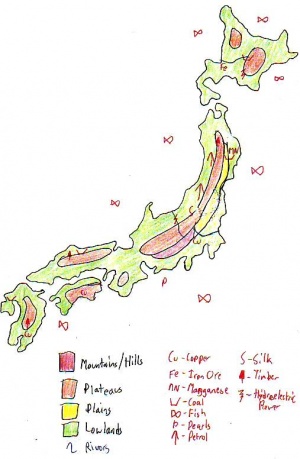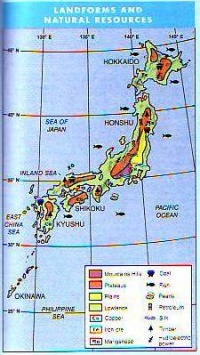World Cultures Portfolio/Japan
From ThePlaz.com
World Cultures Japan Report about Natural Resources
Intro/Basics - Africa - Middle East - South Asia - China - Japan - Korea - Latin America
World Cultures Daily Questions
Notebook
- Page 93 - Japan Political Map, Geo Notes
- Page 94 - Shinto Myth Text, Flowchart
- Page 94 - Major Religions Truths, Page 2
- Page 95 - Japanese History Timeline, Page 2, Page 3, Page 4
- Page 96 - Shinto Notes, Shinto Beliefs, Page 2
- Page 97 - Japansese Women Article, Page 2, Page 3
- Adaptations Chart, Page 2 (Incorrect!!!)
Portfolio
- Portfolio
- Natural Resources Report
- Japanese Violence Journal
Africa: HDI Graph Reflections - Decolonization Report
Middle East: Population Density Report - Essay: A Peaceful Vacation
South Asia: Rainfall Report - South Asia Comparisons Graph - Postcards
China: Sphere of Influences Report - Mao Button Journal
Japan: Natural Resources Report - Japanese Violence Journal
Korea: Physical Map Report
Latin America: Landforms Report
Worldwide: T-Shirt Trade Report
Japan, n nation unlike any other; fiercely independent and self-sufficient for centuries, it has now arisen into one of the most powerful industrial nations on earth. Japan has managed to get around its small size due to the fierce loyalty and trustworthiness of the Japanese people. For centuries, Japan's lack of resources did not hurt it. It had what it needed. But as the age of industrialization came, Japan knew it needed more. It went to war to try and steal natural resources from others. Today, the old boundaries came back. But Japan has realized how to industrialize itself without the need for many domestic natural resources.
Japan's rose up from the sea via volcanoes which make up the ring of fire. This has many implications for the Japanese. Unlike normal earth, volcanic rock doesn't hold many resources. All of the plants and animals must have come from the mainland. In addition, the fault lines mean a large possibility for earthquakes and volcanoes. More then thirty active volcanoes make up Japan, and as many as 1,500 tremors happen each year (Ahmad et al 390). These can have devastating damage on the buildings of the Japanese. They have dedicated entire research institutes to researching earthquakes and earthquake proof buildings.
Japan, like Korea, has many mountains. More than four-fifths of Japan has little population living in it due to the mountains (Ahmad et al 390). This means that almost of the 125 million people live in the small coastal plains near the ocean (Ahmad et al 390). As a comparison, Japan has the seventh largest population squeezed in to a nation a bit larger then Great Britain, and remember to subtract the uninhabited mountain areas.
Japan has managed, somewhat, to deal with its small space. Many Americans think of the capsule hotels when they think of that problem. The hotels "room" only consist of a bed, like a bunk bed, but with the smaller end facing the room. They have a door which can close for privacy and peace. However, most tourists sleep there only one night for the novelty. In addition, the Japanese also use technology to solve their problems, such as a robotic parking garage. You drive your car onto a platform; get out, pay, and then the platform moves your car into a slot for storage.
Japan has some natural resources. The map indicates that all but the smallest island in Japan contain coal (Global Insights: People and Cultures). As industrialization started, one needed coal as the primary fuel source. Today oil has taken coal's place. A small amount of oil exists in the north of Honshu (Global Insights: People and Cultures). In addition, Honshu Island has many trees which one can harvest for lumber (Global Insights: People and Cultures). Paper and furniture then get produced from that wood. Also on the islands of Honshu and Hokkaido fast flowing streams have the potential for hydroelectric power plants (Global Insights: People and Cultures). Hydroelectric power will not run out and does not directly pollute the environment. The island of Honshu also produces silk (Global Insights: People and Cultures). Silk worms require mulberry leaves and silk gets spun into clothing.
The waters around Japan have many fish in them (Global Insights: People and Cultures). Fish represents an important source of protein for the Japanese people (Ahmad et al 391). Historically, the Japanese did not get enough protein from the rice and other crops, so they turned to the sea (Ahmad et al 391). The ocean provides sardines, tuna, herring, salmon, cod, and halibut (Ahmad et al 391). In addition the inland seas provide shell-fish and seaweed (Ahmad et al 391). Often the Japanese get associated with fish and fishing.
However, Japan has a very limited amount of mineral resources (Ahmad et al 391). In the northern island of Hokkaido, iron ore exists in the southern part of the island (Global Insights: People and Cultures). In the north of Honshu, one can mine manganese (Global Insights: People and Cultures). One needs manganese to make steel, an important industry in Japan. In addition, in the south of Honshu, and on the islands of Shikoku, one can find copper (Global Insights: People and Cultures). Wires commonly use copper as it’s one of the best conductors.
Before industrialization, Japan did not have much of a need for these resources; they had enough with what they had. However, as factories started processing the minerals much faster, the resources could no longer feed the need. Thus, the Japanese invaded other nations like Korea and China to try use their resources. Due to their loss in World War Two, they needed to give up their colonies. Today they import iron ore from the Philippines, Malaysia, Australia, and India (Ahmad et al 391). North America, South Africa, and Australia provide coal (Ahmad et al 391). In addition they get oil from the Middle East (Ahmad et al 391).
Today Japan imports and exports many goods. The 2007 CIA World Factbook lists the following as Japan's primary exports: "transport equipment, motor vehicles, semiconductors, electrical machinery, [and] chemicals" (USA CIA). Their primary imports, as of 2001, include: "machinery and equipment, fuels, foodstuffs, chemicals, textiles, [and] raw materials" (USA CIA). Common agricultural items grown include: "rice, sugar beets, vegetables, fruit, pork, poultry, dairy products, eggs, [and] fish" (USA CIA). Large industries include: "motor vehicles, electronic equipment, machine tools, steel and nonferrous metals, ships, chemicals, textiles, [and] processed foods"(USA CIA).
Japan's natural resources have defined, helped, and hurt Japan. The tall mountains restrict arable land and force most of the population into a small area. The resources such as fish have helped their diet for centuries. But their lack of mineral resources hurt it as it industrialized. It represented a primary cause of its own imperialising history. The mountains squashed the population into a small area. However, today Japan has managed to peacefully import needed resources to power its large industry and economy and represents a success.
Sources
- Ahmad, Ifikhar, Herbert Brodsky, Marylee Susan Crofts, and Elisabeth Gaynor Ellis. World Cultures: A Global Mosaic. Upper Saddle River, New Jersey: Prentice Hall, 2001.
- Global Insights: People and Cultures. Glencoe/McGraw-Hill, 1993.
- United States. Central Intelligence Agency. “Japan.” World Factbook. 2007. 20 Jan 2007. <https://www.cia.gov/cia/publications/factbook/geos/ja.html>.




